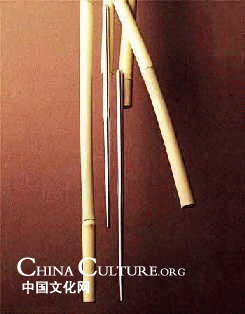To taste oriental culture – starting from bowls and chopsticks
 |
|
A red porcelain bowl seems more remarkable in the plain background. |
Chopsticks, a great intellectual achievement
Chopsticks play an important role in Chinese food culture. Chopsticks are a pair of small equal-length tapered sticks, which are generally believed to have originated in ancient China, showing the special long standing civilization of the nation. They are the traditional eating utensils of China, and are also widely used in Japan, Korea, Taiwan, and Vietnam.
 |
|
Chinese are fond of bamboo chopsticks. This pair of black and red bamboo chopsticks makes your dining handier. |
When the Chinese began to use chopsticks as an eating instrument is anybody’s guess. They were first mentioned in writing in Liji (The Book of rites), a work compiled some 2,000 years ago, but certainly they had their initial form in the twigs which the primitive Chinese must have used to pick up a roast after they began to use fire. It is likely that people cooked their food in large pots which retained heat well, and hasty eaters then broke twigs off trees to retrieve the food. The earliest evidence of a pair of chopsticks made out of bronze was excavated from Yin Ruin’s Tomb 1005 at Houjiazhuang, Anyang, Henan province, dated roughly 1200 BC.
 |
|
Qing gold inlayed jade chopsticks |
The pieces of food were small enough that they negated the need for knives at the dinner table, and chopsticks became staple utensils. It is also thought that Confucius, a vegetarian, advised people not to use knives at the table because knives would remind them of the slaughterhouse.
Simply a pair of chopsticks can fulfill all the functions at table, and compared with western table wares of “waving knife”, they have a sense of “harmony.” And chopsticks are seen as lucky items in ceremonies by many nationalities.
Chinese chopsticks are usually 9 to 10 inches long and rectangular with a blunt end. Bamboo has been the most popular material because it is inexpensive, readily available, easy to split, resistant to heat, and has no perceptible odor or taste.
The Chinese word for chopsticks is “kuaizi”. “Kuai” is a semantic-phonetic compound with a phonetic part of the word “quick”. In Chinese, the old word for “chopsticks” was “zhu”. However, “zhu” became a taboo on ships because it sounded the same as another word meaning “to stop”. Consequently, it was replaced by a word of opposite meaning, “kuai” (fast, quick). This gradually spread until it became the word for “chopsticks” in most varieties of modern Chinese.
 |
For westerners who are used to the knife and fork, to learn how to use chopsticks isn’t an easy task, but once you master them, they are simple and convenient. No wonder many western scholars praise chopsticks as a great crystallization of Chinese wisdom.


















